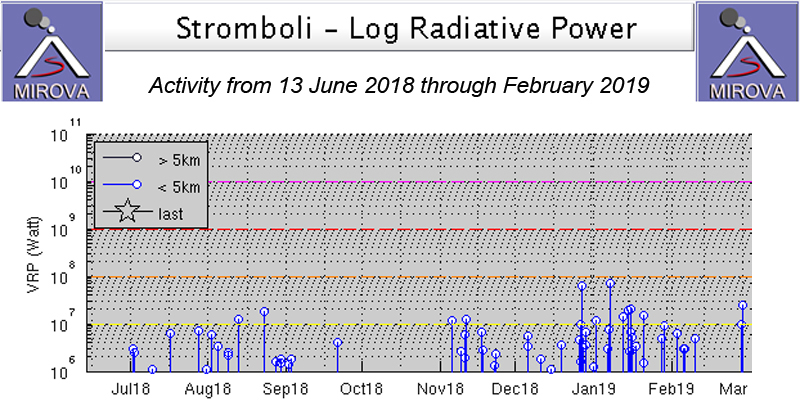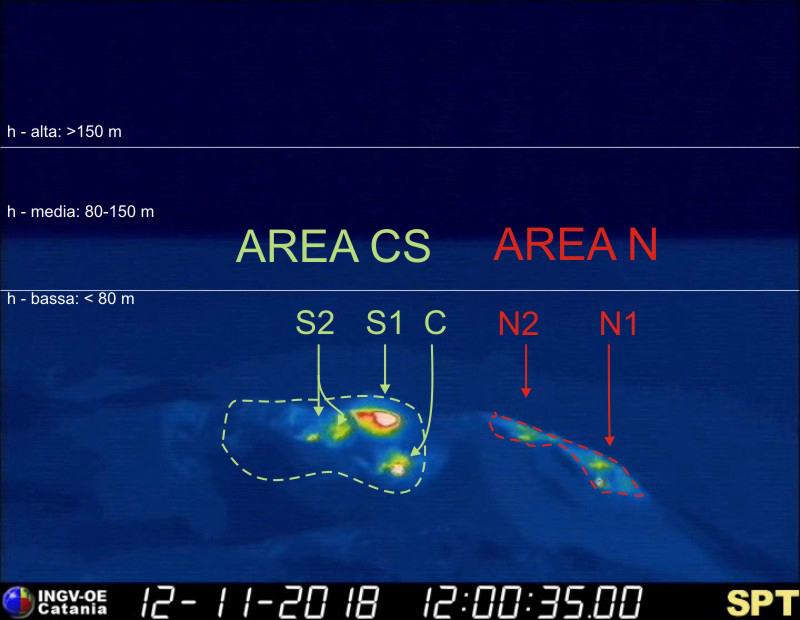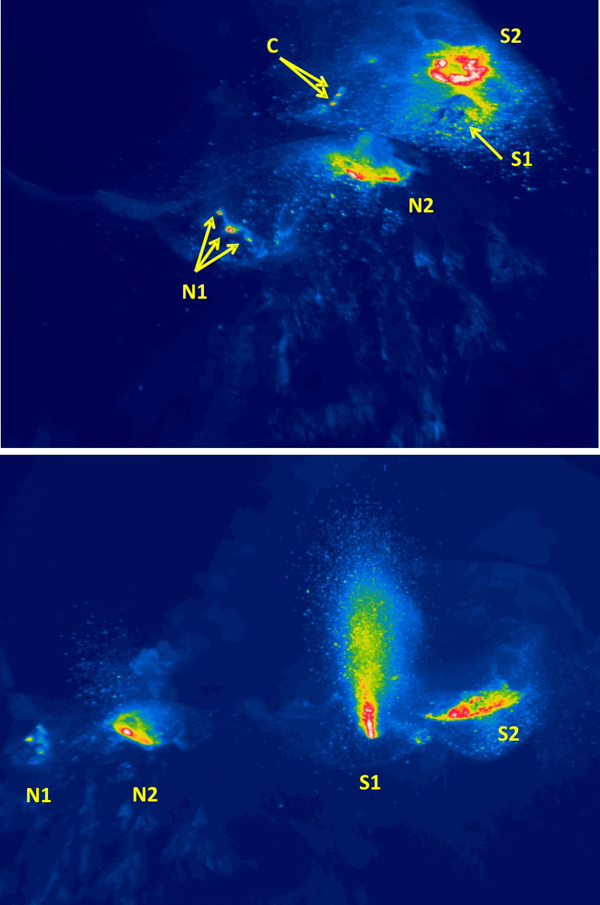Report on Stromboli (Italy) — March 2019
Bulletin of the Global Volcanism Network, vol. 44, no. 3 (March 2019)
Managing Editor: Edward Venzke.
Edited by A. Elizabeth Crafford.
Stromboli (Italy) Constant explosions from both crater areas during November 2018-February 2019
Please cite this report as:
Global Volcanism Program, 2019. Report on Stromboli (Italy) (Crafford, A.E., and Venzke, E., eds.). Bulletin of the Global Volcanism Network, 44:3. Smithsonian Institution. https://doi.org/10.5479/si.GVP.BGVN201903-211040
Stromboli
Italy
38.789°N, 15.213°E; summit elev. 924 m
All times are local (unless otherwise noted)
Nearly constant fountains of lava at Stromboli have served as a natural beacon in the Tyrrhenian Sea for at least 2,000 years. Eruptive activity at the summit consistently occurs from multiple vents at both a north crater area (N Area) and a southern crater group (CS Area) on the Terrazza Craterica at the head of the Sciara del Fuoco, a large scarp that runs from the summit down the NW side of the island. Thermal and visual cameras that monitor activity at the vents are located on the nearby Pizzo Sopra La Fossa, above the Terrazza Craterica, and at a location closer to the summit craters.
Eruptive activity from November 2018 to February 2019 was consistent in terms of explosion intensities and rates from both crater areas at the summit, and similar to activity of the past few years (table 5). In the North Crater area, both vents N1 and N2 emitted a mixture of coarse (lapilli and bombs) and fine (ash) ejecta; most explosions rose less than 80 m above the vents, some reached 150 m. Average explosion rates ranged from 4 to 21 per hour. In the CS crater area continuous degassing and occasional intense spattering were typical at vent C, vent S1 was a low-intensity incandescent jet throughout the period. Explosions from vent S2 produced 80-150 m high ejecta of ash, lapilli and bombs at average rates of 3-16 per hour. Thermal activity at Stromboli was actually higher during November 2018-February 2019 than it had been in previous months as recorded in the MIROVA Log Radiative Power data from MODIS infrared satellite information (figure 139).
Table 5. Summary of activity levels at Stromboli, November 2018-February 2019. Low intensity activity indicates ejecta rising less than 80 m and medium intensity is ejecta rising less than 150 m. Data courtesy of INGV.
| Month | N Area Activity | CS Area Activity |
| Nov 2018 | Low- to medium-intensity explosions at both N1 and N2, lapilli and bombs mixed with ash, explosion rates of 6-16 per hour. | Continuous degassing at C; intense spattering on 26 Nov. Low- to medium-intensity incandescent jetting at S1. Low- to medium-intensity explosions at S2 with a mix of coarse and fine ejecta and explosion rates of 3-18 per hour. |
| Dec 2018 | Low- to medium-intensity explosions at both N1 and N2, coarse and fine ejecta, explosion rates of 4-21 per hour. Three days of intense spattering at N2. | Continuous degassing at C; intense spattering 1-2 Dec. Low- to medium-intensity incandescent jets at S1, low and medium-intensity explosions of coarse and fine material at S2. Average explosion raters were 10-18 per hour at the beginning of the month, 3-4 per hour during last week. |
| Jan 2019 | Low- to medium-intensity explosions at N1, coarse ejecta. Low- to medium-intensity and spattering at N2, coarse and fine ejecta. Explosion rates of 9-16 per hour. | Continuous degassing and low-intensity explosions of coarse ejecta at C. Low-intensity incandescent jets at S1. Low- and medium-intensity explosions of coarse and fine ejecta at S2. |
| Feb 2019 | Medium-intensity explosions with coarse ejecta at N1. Low-intensity explosions with fine ash at N2. Explosion rates of 4-11 per hour. | Continuous degassing and low-intensity explosions with coarse and fine ejecta at C and S2. Low intensity incandescent jets at S1. Explosion rates of 2-13 per hour. |
Activity at the N area was very consistent during November 2018 (figure 140). Explosions of low-intensity (less than 80 m high) to medium-intensity (less than 150 m high) occurred at both the N1 and N2 vents and produced coarse material (lapilli and bombs) mixed with ash, at rates averaging 6-16 explosions per hour. In the SC area continuous degassing was reported from vent C with a brief period of intense spattering on 26 November. At vent S1 low- to medium-intensity incandescent jetting was reported. At vent S2, low- and medium-intensity explosive activity produced a mixture of coarse and fine (ash) material at a frequency of 3-18 events per hour.
Similar activity continued during December at both crater areas, although there were brief periods of more intense activity. Low- to medium-intensity explosions at both N area vents produced a mixture of coarse and fine-grained material at rates averaging 4-21 per hour. During 6-7 December ejecta from the N vents fell onto the upper part of the Sciara del Fuoco and rolled down the gullies to the coast, producing tongues of debris (figure 141). An explosion at N1 on 12 December produced a change in the structure of the crater area. During 10-16 December the ejecta from the N area landed outside the crater on the Sciara del Fuoco. Intense spattering was observed from N2 on 18, 22, and 31 December. In the CS area, continuous degassing took place at vent C, along with a brief period of intense spattering on 1-2 December. Low to medium intensity incandescent jets persisted at S1 along with low-and medium-intensity explosions of coarse and fine-grained material at vent S2. Rates of explosion at the CS area were higher at the beginning of December (10-18 per hour) and lower during the last week of the month (3-4 per hour).
Explosive intensity was low (ejecta less than 80 m high) at vent N1 at the beginning of January 2019 and increased to medium (ejecta less than 150 m high) during the second half of the month, producing coarse ejecta of lapilli and bombs. Intensity at vent N2 was low to medium throughout the month with both coarse- and fine-grained material ejected. Explosions from N2 sent large blocks onto the Sciara del Fuoco several times throughout the month and usually was accompanied by intense spattering. Explosion rates varied, with averages of 9 to 16 per hour, throughout the month in the N area. In the CS area continuous degassing occurred at vent C, and low-intensity explosions of coarse-grained material were reported during the second half of the month. Low-intensity incandescent jets at S1 along with low- and medium-intensity explosions of coarse and fine-grained material at S2 persisted throughout the month.
A helicopter overflight of Stromboli on 8 January 2019 allowed for detailed visual and thermal observations of activity and of the morphology of the vents at the summit (figure 142). Vent C had two small hornitos, and a small scoria cone was present in vent S1, while a larger crater was apparent at S2. In the N crater area vent N2 had a large scoria cone that faced the Sciara del Fuoco to the north; three narrow gullies were visible at the base of the cone (figure 143). Vent S1 was a large crater containing three small vents aligned in a NW-SE trend; INGV scientists concluded the vents formed as a result of the 12 December 2018 explosion. Thermal images showed relatively low temperatures at all fumaroles compared with earlier visits.
Activity during February 2019 declined slightly from the previous few months. Explosions at vent N1 were of medium-intensity and produced coarse material (lapilli and bombs). At N2, low-intensity explosions produced fine ash. Average explosion rates in the N area ranged from 4-11 per hour. At the CS area, continuous degassing and low-intensity explosions produced coarse and fine-grained material from vents C and S2 while low-intensity incandescent jets were active at S1. The explosion rates at the CS area averaged 2-13 per hour.
Geological Summary. Spectacular incandescent nighttime explosions at Stromboli have long attracted visitors to the "Lighthouse of the Mediterranean" in the NE Aeolian Islands. This volcano has lent its name to the frequent mild explosive activity that has characterized its eruptions throughout much of historical time. The small island is the emergent summit of a volcano that grew in two main eruptive cycles, the last of which formed the western portion of the island. The Neostromboli eruptive period took place between about 13,000 and 5,000 years ago. The active summit vents are located at the head of the Sciara del Fuoco, a prominent scarp that formed about 5,000 years ago due to a series of slope failures which extends to below sea level. The modern volcano has been constructed within this scarp, which funnels pyroclastic ejecta and lava flows to the NW. Essentially continuous mild Strombolian explosions, sometimes accompanied by lava flows, have been recorded for more than a millennium.
Information Contacts: Istituto Nazionale di Geofisica e Vulcanologia (INGV), Sezione di Catania, Piazza Roma 2, 95123 Catania, Italy, (URL: http://www.ct.ingv.it/en/); MIROVA (Middle InfraRed Observation of Volcanic Activity), a collaborative project between the Universities of Turin and Florence (Italy) supported by the Centre for Volcanic Risk of the Italian Civil Protection Department (URL: http://www.mirovaweb.it/).






